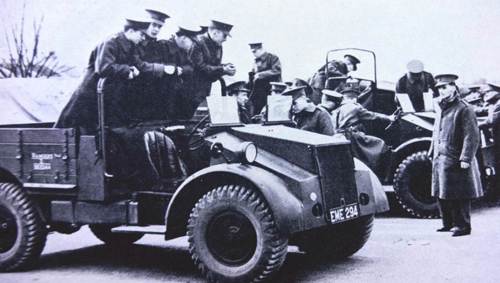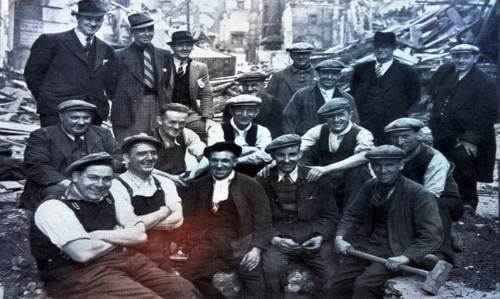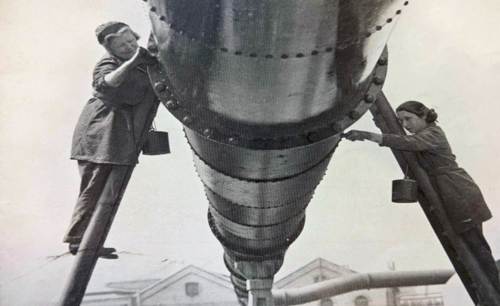Centrica and British Gas recognising the remarkable role our people played during WWII
The First World War was believed to be ‘"the war to end all wars" yet only two decades later, peace was shattered as global destruction reigned with the outbreak of the Second World War. Through Centrica’s origins in the 1812 Gas, Light and Coke Company (GLCC) from which the entire industry stemmed, our people played a central role in the war effort, fighting on the front line and fuelling the war machine at home. For Remembrance Day, we wanted to recognise the bravely of our people who devoted their lives to securing Britain’s victory in WWII so that we could live in democracy, freedom and tolerance today.
Battling war on all fronts
At the outbreak of war, many employees gallantly enrolled on active service despite having experienced the horrors of the Great War. Among those deployed first were members of the Company’s Territorial Army regiments, which were almost at full capacity following recruitment leading up to war. Brave apprentices, gas stokers and meter readers therefore left their civic lives in exchange for fighting on the front lines - 402 of whom tragically made the ultimate sacrifice1. The selfless duty of those in combat was appreciated by all at the Company and it was resolved that as far as possible, all jobs would remain open for their safe return while a number of insurance and sickness schemes ensured that any worker and their family would be protected from injury or death.

New recruits learning to drive military vehicles
At the same time, employees on the home front faced battle from the skies with an unprecedented barrage of bombs, causing severe damage to Britain’s gas supplies which were vital to the war-effort. The gas companies were prepared, but it was a huge undertaking with over 14,000 miles of mains carrying gas from 52 plants through more than 3 million meters of pipes to homes, businesses and factories throughout London2.
Neighbouring gas companies put aside fierce competition to voluntarily pool resources through the newly created London Regional Gas Centre, which co-ordinated repair services day and night so that districts badly damaged by bombing could receive the swift support of repair gangs from less affected areas. Consequently, gas men faced grave danger as duty often took them out during the worst of the aerial conflict. For example, when St Paul’s Cathedral was bombed in 1940, our people fought flames and fire to stop the flow of gas from a burning main right next to the bomb, which made it possible for the Royal Engineers to enter the area and deactivate the explosive. Thanks to these men who worked tirelessly with a disregard of danger, disaster was averted and the landmark remains standing today. The repair gangs evidently lived up to the Company’s motto to ‘not let London down’ and in total, they repaired 20,500 incidents throughout the war3.

The repair gang who saved St Paul’s Cathedral
The Company’s gas works received deliberate and fierce attack in an attempt to cripple gas production. In 1940, all ten gas holders at the Beckton Gas Works were substantially damaged but employees faced the problem head on; working long and hard to ensure Britain continued to benefit from its supply by immediately pumping the gas to nearby Works. By 1944 however, destruction had reached new heights and many gas holders had been totally destroyed.
Maintaining gas production and supply was therefore challenging. To defeat this problem, District Report Centres provided an hourly update on gas stocks and reported emergencies to the Control Room which was set deep underground at Westminster. When destruction interrupted production, the Control Room ordered gas companies to take immediate action and increase production to fill the void.
The plight of the gas company was recognised by many consumers who expressed their sincere gratitude for providing a consistent supply, which bought a sense of normality to lives that had been turned upside down.
A consumer from West Kensington said, “When my gas came on yesterday to a renewed good pressure, I was amazed, knowing the appalling conditions you have had to face during this last week. So filled with admiration am I at the bravery and devotion your staff must have shown, that I feel impelled to write expressing, as a very humble member of your clientele, my feelings. Indeed, London feels that things cannot be really bad while the essential services carry on, and your staff must be doing incalculable good in keeping morale high”.
Despite the inherent danger, it is remarkable that only 15 employees lost their lives on the home front. The workers’ courage earned them 20 George Medals alongside many other awards.
W. Harris, a GLCC Gas Fitter and soldier on active duty overseas commentated, “I was very proud to read of the awards for bravery to my fellow workmates; the way they are carrying on the traditions of the company is grand. It is comforting to know that our folks at home are in such good hands. The less said about this part of the world the better…The best of luck to the old firm”.
Our people were also busy installing lights in hospitals, refrigerators in submarines and cookers in new evacuee homes and barracks. So with war dictating increased duties but fewer men to complete the work, women were again called upon to plug the employment gap. Women eagerly adopted important responsibilities from meter reading to maintaining gas production. In spite of long hours, uncomfortable conditions and personal danger, the women excelled at their wartime roles which induced the respect of their male colleagues and paved the way for women in the energy industry.

Women workers doing their bit at the gas works
Being an effective cog in the war machine
The gas industry was of critical national importance because it not only maintained Britain’s gas supply, but was a reservoir of raw materials and by-products vital to the war machine. So while the GLCC suffered deeply from a curtailment of commercial activities by the circumstances of war, they faced enormous pressure to step up the extraction of materials while balancing the urgent demand for gas. But the people of the company fulfilled this duty with extreme efficiency. The productive capacity of the industry had increased 50% since 1918 while improvements in by-product recovery meant that every gramme of value could be extracted4. Overnight, coal was seamlessly turned into explosives for battle, powerful disinfectants and drugs for hospitals, special paints for camouflage, resin for aeroplane parts and fertilisers for food - all of which contributed to Britain’s victory.
To feed war’s appetite for coal, the Company’s colliers were essential in securing supplies needed to defeat the enemy. The colliers passage was however riveted with peril and it was not long before disaster struck - within the first three months of war, 18 crew members from the ‘ S.S Torchbearer’ and ‘S.S Whitemantle’ lost their lives to the German naval offensive.
Captain R. L. Jones of the ‘S.S Halo’which was later torpedoed said, “You’ve not only got to dodge the mines. You’ve got to keep out of the way of those Nazi planes…on my last trip but one Hitler came out from Whitby and dropped six bombs only 50 yards astern of us. The trip before that we were in the Saturday Raid at the Humber. And – touch wood! – we dodged them again…Friends of mine – shipmates, colleagues, men I’ve worked with for a good many years – haven’t been so lucky. But we keep bringing in the coal. It will take more than Hitler to stop us doing that. And it’s good to know, when we do safely dock, that every cargo of coal we deliver to the piers is another blow at Hitler”.
As war progressed, pressure for supplies increased as the number of ships scuttled or requisitioned by Government grew. ‘Mr Therm’ for example was requisitioned and became one of the first ships to unload troops at Normandy having been modified with extra armaments5.
Technical specialists from the GLCC also supported the Government war effort. F.M. Birks played a prominent part in the development of the Fog Dispersal scheme for airfields, which used heat generated from the Company’s coke for a secret petrol-burning device that dissipated fog. The scheme enabled bombing operations to continue and was estimated to have saved 10,000 airmen from death as well as 2,500 bombers6. 400 of our Industry Home Service Advisors also helped the Ministry of Food communicate their Education Campaign through demonstrations that assisted women to economise food and gas while keeping their families healthy.

Home Service Advisors providing a cooking demonstration
Sam Laidlaw, CEO, Centrica said, “Our colleagues at the Gas, Light and Coke Company compel our admiration for their brave devotion to duty during the First and Second World Wars. We will never forget the important contribution they have made to Britain’s history and the legacy war has had on our country, industry and company today”.
-
Centrica Media Relations